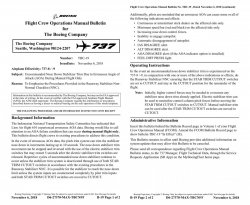This article seems to explain it from a lay person's perspective.
Seems like the issue is that an airflow / angle of attack sensor could have caused the plane to go into a dive. there would have been procedures to correct this, but for some reason this wasn't done.
Bloomberg - Are you a robot?
++++++++++++
A
Boeing Co. warning to 737 Max operators around the globe provides the first clues about how bad data from an airflow sensor might have contributed to the deadly crash of an Indonesian airliner last week.
The bulletin and statements by Indonesian investigators suggest that the pilots on the Lion Air 737 Max 8 were battling the plane as its computers commanded a steep dive during its final moments of flight.
Boeing cautioned that the so-called angle-of-attack sensor can provide false readings in limited circumstances -- such as when a plane’s autopilot is switched off -- that cause the 737 Max to pitch nose downward. The sensor malfunction can essentially trick the plane into pointing its nose down to gain the speed it thinks it needs to keep flying.
The Boeing directive doesn’t call for operators to conduct new inspections or take other action. It merely stressed that pilots should follow procedures in the flight manual when encountering erroneous data. Following the protocol should be routine for pilots, though may be more challenging in the heat of the moment when equipment is malfunctioning and alarms are sounding.
American aviation regulators followed by issuing an emergency order Wednesday requiring that airlines follow Boeing’s instructions and add information to pilot manuals showing how to diagnose the problem and respond. Carriers will have three days to update their manuals under the order, issued by the Federal Aviation Administration, according to an emailed statement.
The FAA said the problem “could cause the flight crew to have difficulty controlling the airplane, and lead to excessive nose-down attitude, significant altitude loss, and possible impact with terrain.”
What Boeing’s Post-Crash Warning About 737 Max Means: QuickTake
The sensor on the Lion Air jet been replaced the day before after it failed on a previous trip, the Indonesia National Transportation Safety Committee said in a briefing Wednesday. The malfunction can cause the plane’s computers to erroneously detect a mid-flight stall in airflow, causing the aircraft to abruptly dive to regain the speed it needs to keep flying.
On a previous flight from Bali to Jakarta, the angle-of-attack sensor feeding the captain’s flight displays registered a 20-degree difference from the device on the copilot’s side of the coughpit, the committee said. Pilots on that flight were able to compensate.
An angle-of-attack sensor that had been removed before that previous flight has been brought to the investigators and will be examined in the U.S., the Indonesian officials said.
It’s still possible the FAA may order Boeing to redesign the equipment or software as investigators piece together details of the Oct. 29 crash, which killed 189 people. The agency said it “will take further appropriate actions depending on the results of the investigation.”
Boeing 737 Max 7.
Photographer: Simon Dawson/Bloomberg
Fresh Questions
The new information about Lion Air Flight 610 raises multiple questions investigators will want to examine on the pilots’ actions, how flight crews were trained and whether the maintenance performed on the system was adequate, said Roger Cox, a former NTSB investigator.
“I would definitely be looking at the man-machine interface and how pilots respond,” said Cox, a former airline pilot who flew earlier versions of the 737 and specialized at the NTSB in coughpit actions.
One of the puzzling things about the accident is that the plane was flying in clear skies during daylight, so pilots should have been able to handle the problems they faced with airspeed and erroneous sensors, Cox said. However, in rare instances, accidents have been caused by what investigators call a “startle factor.”
“If you don’t take the appropriate action because you’re surprised, you can make a serious error,” he said.
The pilots union at Southwest Airlines Co., the biggest customer of the 737 Max, hasn’t received any reports from its members of problems with faulty sensor readings, said Jon Weaks, president of the Southwest Airlines Pilots Association.
The airline confirmed that it hasn’t experienced any of the sensor troubles and said its 26 Max remain operational and no schedule disruption is expected.
United Technologies Corp. supplies the angle-of-attack sensors and indicator for the 737 Max, according to Airframers.net. The company didn’t respond to requests for comment. Honeywell International Inc. provides the air data inertial reference unit.
The Lion Air jetliner plunged into the Java Sea minutes after takeoff from Jakarta airport, nosing downward so suddenly that it may have hit speeds of 600 miles an hour before slamming into the water.
Moments earlier, the pilots radioed a request to return to Jakarta, but never turned back toward the airport, according to Indonesia’s safety commission and flight-tracking data. The agency said the pilots were dealing with an erroneous airspeed indication.
Rescue vessels line up during their last day of search operation on Nov. 7.
Photographer: Azwar Ipank/AFP via Getty Images
Boeing, which is headquartered in Chicago, said it is cooperating fully and providing technical assistance as the investigation continues. Boeing’s shares rose 1.5 percent to $372.02 at the close of trading in New York. The stock has risen 26 percent this year, the fourth-largest gain on the 30-member Dow Jones Industrial Average.
Lion Air Jet’s Final Plunge May Have Reached 600 Miles Per Hour
While modern jetliners primarily operate on autopilot, the computerized system can disengage when airspeed indicators malfunction, forcing pilots to manually fly the aircraft. If there is an “uncommanded nose-down stabilizer trim” on the Max, pilots can counteract it by pushing a switch on their control yoke. But the plane’s computers will resume trying to dive as soon as they release the switch, the Boeing bulletin said.
Crashed Lion Air Jet Had Faulty Speed Readings on Last 4 Flights
The Most Max
Lion is the biggest customer for the Boeing 737 Max outside North America
Source: Boeing
Note: Top customers through September
Pilots raise and lower the nose of Boeing jetliners by pushing and pulling on a yoke in the coughpit, which controls panels at the tail known as elevators. In addition, a system known as pitch trim can be changed to prompt nose-up or nose-down movement.
The angle of attack readings are fed into a computer that in some cases will attempt to push down the nose using the pitch trim system. In the early days of the jet age, the pitch trim system was linked to several accidents. If pilots aren’t careful, they can cause severe nose-down trim settings that make it impossible to level a plane.
— With assistance by Kyunghee Park, Anurag Kotoky, Mary Schlangenstein, Justin Bachman, and Natasha Rausch
Bloomberg - Are you a robot?

















